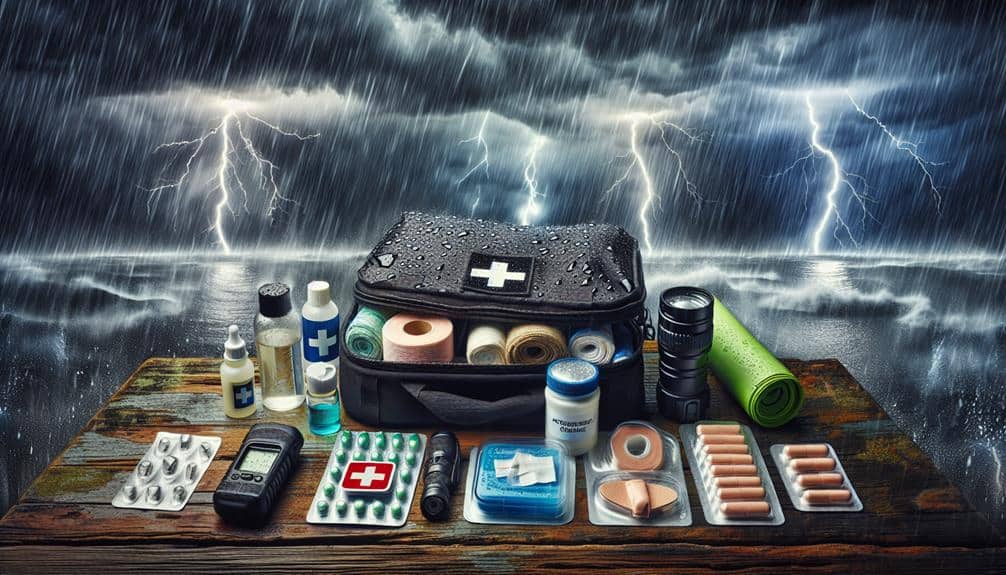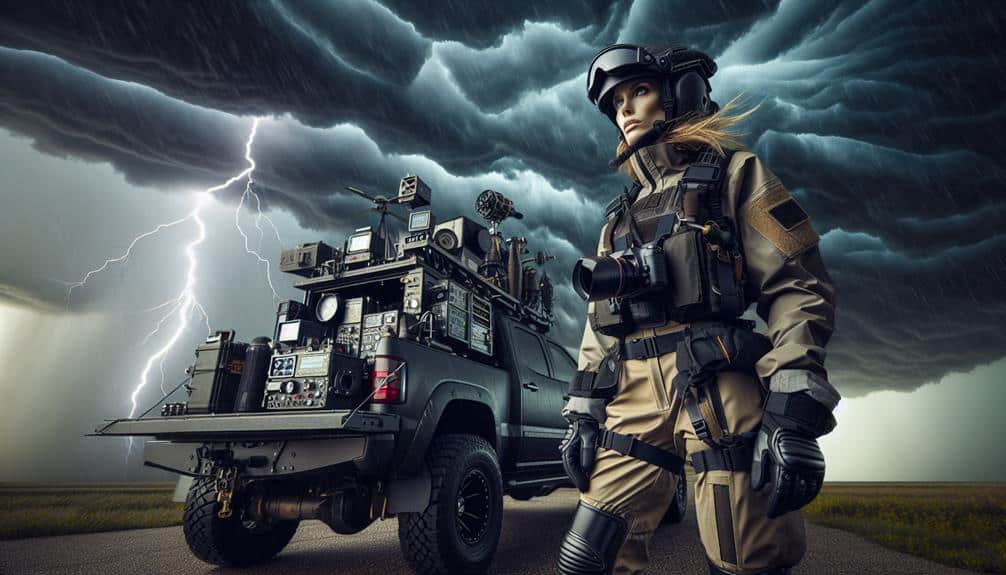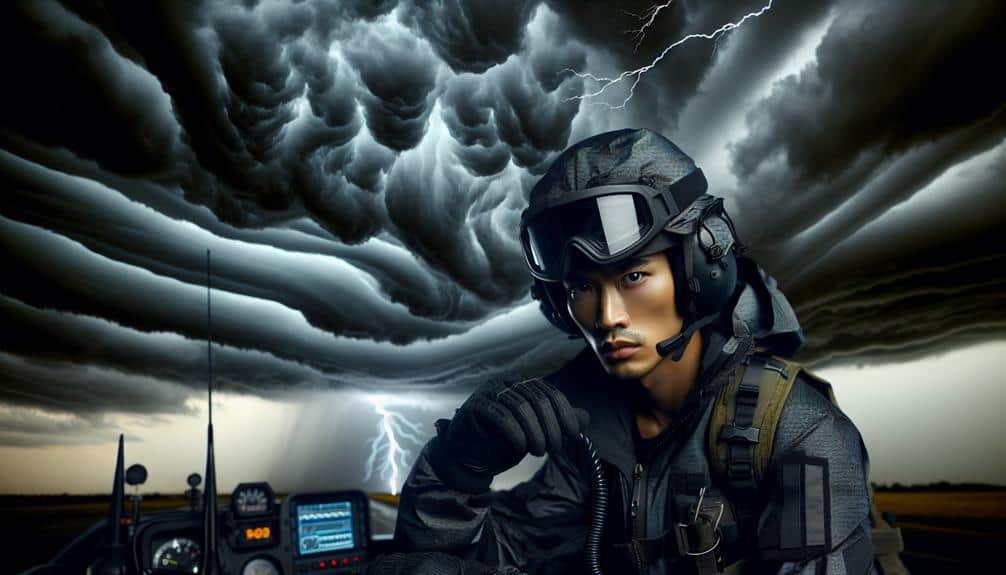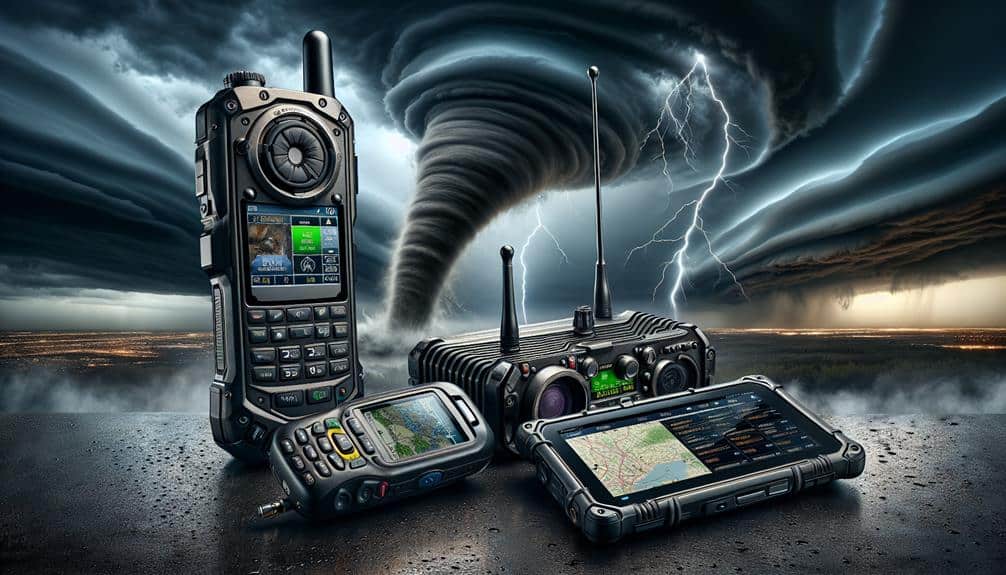As storm chasers, we should prioritize safety near floods by wearing suitable footwear with deep-lug soles and waterproof clothing to prevent waterborne illnesses. Carrying a well-equipped first aid kit is essential for emergency wound care and thermal blankets. Reliable communication devices like two-way radios and GPS ensure team coordination and real-time updates. Identifying emergency shelters and stocking them with necessary supplies like non-perishable food and clean water enhances our emergency preparedness. High-visibility gear with reflective strips and LED lights boosts visibility in low-light conditions. Understanding these precautions can help us stay safe whilst traveling through flood-prone areas.
Key Points
- Wear waterproof footwear with deep-lug soles for stability and protection against waterborne illnesses.
- Carry a well-stocked first aid kit for immediate wound care and infection prevention.
- Use reliable communication devices, including two-way radios and GPS, for real-time updates and coordination.
- Identify and map multiple evacuation routes to higher ground, accounting for road impassability.
Proper Footwear
Proper footwear's essential for storm chasers to guarantee safety and movement in flood-prone areas. When we're traveling through unpredictable terrains, the right shoes can make all the difference.
Proper traction is crucial; it helps prevent slips and falls on wet, muddy surfaces. Studies show that footwear with deep-lug soles provides better grip, enhancing our stability in hazardous conditions.
Additionally, waterproof gear is a non-negotiable aspect of our footwear. Shoes or boots that repel water ensure our feet stay dry, reducing the risk of blisters and infections that could hinder our mobility. According to data from the National Weather Service, storm chasers operating in flood zones face a significantly higher risk of waterborne illnesses, making waterproof footwear a critical line of defense.
We should also consider the material and construction of our footwear. High-quality, breathable materials keep our feet comfortable and ventilated, while reinforced toe caps and ankle support protect against debris and sudden impacts.
Waterproof Clothing
When selecting waterproof clothing, we must prioritize durable materials that can withstand harsh conditions.
It's important to make sure that our gear fits well and offers comfort during extended periods of wear.
Choose Durable Waterproof Materials
Selecting long-lasting waterproof materials for clothing is essential to guarantee our safety and comfort while storm chasing near floods. When we're out in the field, we need waterproof gear that can withstand harsh conditions, keeping us dry and protected.
Reliable waterproof clothing allows us to focus on capturing data without worrying about getting soaked or developing hypothermia. Choosing the right materials involves understanding the science behind waterproof fabrics. High-quality options often include membrane-based materials like Gore-Tex, which offer both breathability and waterproofing. These fabrics prevent water from penetrating while allowing sweat to escape, ensuring we remain comfortable during intense activities.
To optimize our storm-chasing gear, we should consider the following:
- Waterproof Jackets: Look for jackets with sealed seams and sturdy zippers. These features prevent water ingress and enhance longevity.
- Protective Footwear: Invest in waterproof boots with non-slip soles. They provide essential traction and prevent slipping on wet surfaces.
Ensure Proper Fit and Comfort
While selecting durable waterproof materials is essential, we must also make certain our waterproof clothing fits well and offers comfort during storm chasing near floods. Ill-fitting gear can impede our mobility, reduce effectiveness, and compromise safety. Data shows that clothing that's too tight can restrict movement and circulation, while excessively loose garments can snag on debris or get caught in fast-moving water.
Comfort is equally important. Extended periods in uncomfortable clothing can lead to fatigue, which impairs our ability to make quick decisions—a crucial factor in emergency planning. Breathable, waterproof fabrics help regulate body temperature, which is crucial for maintaining focus and energy during intense weather monitoring.
Proper fit and comfort also tie into our hydration strategies. Well-fitted gear allows for easier access to water supplies and hydration packs, ensuring we stay hydrated without unnecessary hassle. Moreover, regular equipment maintenance ensures zippers and seams remain functional, preserving the integrity of our waterproof clothing.
We must also consider the need for quick adjustments. Adjustable cuffs, hems, and hoods allow us to tailor our gear to changing conditions, enhancing both comfort and safety. By prioritizing fit and comfort, we're better prepared to face the challenges of storm chasing near floods.
First Aid Kit

A well-stocked first aid kit is necessary for storm chasers to address potential injuries and medical emergencies encountered near flood zones. Given the unpredictable nature of floods, it's important that we're prepared to handle emergency response and wound care swiftly and efficiently. Flood environments present unique risks such as cuts from debris, hypothermia, and infections. Our first aid kits should be thorough, portable, and ready for rapid deployment.
Key items to include in our first aid kit are:
- Antiseptic wipes and ointments: These are essential for cleaning wounds and preventing infections, which can be particularly severe in flood conditions.
- Bandages and sterile gauze: Necessary for wound care, bandages and gauze help in managing bleeding and protecting injuries from contaminants.
Staying equipped with a well-prepared first aid kit empowers us to act decisively in emergency situations, ensuring our safety and that of our team members. By prioritizing emergency response and wound care, we maximize our freedom to chase storms effectively and return safely.
Communication Devices
Effective communication devices are essential for storm chasers operating near floods to guarantee real-time updates and coordination with team members and emergency services.
In our line of work, having reliable signal devices guarantees we stay connected, even in remote areas where cell reception is spotty. Utilizing two-way radios with a range of several miles allows us to maintain constant contact, which is critical for sharing observations and warning others of imminent dangers.
GPS tracking devices are another indispensable tool. By outfitting our vehicles and personnel with GPS, we can accurately monitor our locations and movements. This data-driven approach not only enhances our safety but also streamlines coordination with emergency services. When every second counts, being able to relay precise locations can facilitate quicker evacuations and more efficient rescues.
Satellite phones serve as a robust backup when all else fails, providing a lifeline to the outside world. In addition, mobile apps designed for storm chasers can offer real-time weather updates, flood alerts, and communication platforms, improving our overall situational awareness.
Emergency Shelters

When it comes to emergency shelters, we must identify safe locations well in advance to guarantee our safety during floods.
It's essential to stock these shelters with necessary emergency supplies, such as food, water, first aid kits, and communication devices.
Identifying Safe Locations
Locating emergency shelters before heading out can significantly increase our chances of staying safe during a storm chase near flood-prone areas. By identifying safe locations in advance, we can effectively plan our safe evacuation and make sure we're aware of the best emergency routes to take if conditions deteriorate. This proactive approach not only provides peace of mind but also enhances our ability to make quick, informed decisions when time is of the essence.
To identify safe locations effectively, we should:
- Research local emergency management plans: Many municipalities have detailed emergency management plans available online that include designated shelters and evacuation routes. Reviewing these can provide vital information.
- Utilize technology: Apps and online platforms like FEMA's mobile app offer real-time alerts and data on shelter locations and road conditions, which can be invaluable during a storm chase.
Shelter Emergency Supplies
Stocking emergency shelters with necessary supplies is important for maintaining safety and preparedness during a storm chase near flood-prone areas. We need to prioritize items that sustain us through prolonged emergencies. Non-perishable food, clean water, medical kits, and personal hygiene products should top our list. Data suggests each person requires at least one gallon of water per day, so planning for a minimum of 72 hours is wise.
In addition to these basics, we should consider the significance of having reliable communication tools. Battery-operated radios, spare batteries, and portable chargers ensure we stay informed and connected. Effective communication plans are essential for coordinating with our team and emergency services, especially when traditional networks fail.
Mapping out evacuation routes in advance is another important step. We must identify multiple pathways to higher ground or designated shelters, considering the potential for roads to become impassable. GPS devices and printed maps serve as necessary backups to digital tools that might falter during severe weather.
High-Visibility Gear
Wearing high-visibility gear is crucial for storm chasers to make certain they're easily seen by others, thereby reducing the risk of accidents in low-visibility conditions. When we head out into unpredictable weather, we must prioritize our safety protocols, establishing clear communication plans, and wearing high-visibility protective gear. These steps help ensure that we remain conspicuous to both rescue teams and fellow storm chasers.
High-visibility gear is scientifically proven to enhance our safety during storm chasing endeavors. According to data, high-visibility clothing can decrease the likelihood of accidents by up to 47%. This statistic underscores the critical role such gear plays in our operations.
Beyond just wearing neon colors, we should consider additional elements to enhance our visibility:
- Reflective Strips: Incorporating reflective strips on our jackets and pants increases visibility during night-time or dim conditions.
- LED Lights: Attaching small, battery-operated LED lights to our gear can help make us more noticeable in heavy rain or fog.
Frequently Asked Questions
How Can Storm Chasers Identify Safe Areas to Park Their Vehicles?
Just like Odysseus avoided dangers, we assess flood risk by consulting topographic maps and real-time data. For parking safety, we choose elevated areas away from water bodies, ensuring quick escape routes for our freedom and safety.
What Steps Should Be Taken if Caught in a Flash Flood While Storm Chasing?
If we're caught in a flash flood while storm chasing, we should immediately seek higher ground, avoid driving through floodwaters, and call emergency response. Prioritize survival tactics like staying informed and having an emergency kit ready.
Are There Specific Weather Patterns That Increase Flood Risks During Storm Chasing?
We've found certain weather patterns, like slow-moving thunderstorms and heavy rainfall, greatly increase flood risks. As storm chasers, we must understand these patterns and take safety precautions to avoid dangerous situations and guarantee our safety.
How Do Storm Chasers Monitor Real-Time Updates on Flood Conditions?
We monitor real-time updates on flood conditions using advanced communication systems and emergency response networks. By leveraging radar data, weather apps, and satellite feeds, we stay informed and adapt our strategies, ensuring both safety and freedom in our pursuits.
What Types of Training Should Storm Chasers Undergo to Handle Flood Emergencies?
We should undergo rigorous training in water rescue, risk assessment, and emergency response to guarantee we follow safety protocols. This knowledge empowers us to handle flood emergencies effectively and maintain our freedom to chase storms safely.


